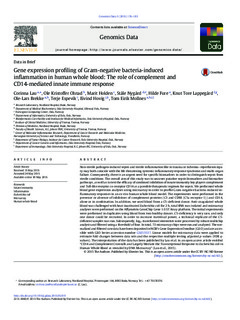| dc.contributor.author | Lau, Corinna | |
| dc.contributor.author | Olstad, Ole Kristoffer | |
| dc.contributor.author | Holden, Marit | |
| dc.contributor.author | Nygård, Ståle | |
| dc.contributor.author | Fure, Hilde | |
| dc.contributor.author | Lappegård, Knut Tore | |
| dc.contributor.author | Brekke, Ole Lars | |
| dc.contributor.author | Espevik, Terje | |
| dc.contributor.author | Hovig, Johannes Eivind | |
| dc.contributor.author | Mollnes, Tom Eirik | |
| dc.date.accessioned | 2016-02-26T12:15:25Z | |
| dc.date.accessioned | 2016-04-01T09:31:37Z | |
| dc.date.available | 2016-02-26T12:15:25Z | |
| dc.date.available | 2016-04-01T09:31:37Z | |
| dc.date.issued | 2015 | |
| dc.identifier.citation | Genomics Data 2015, 5:176-183 | nb_NO |
| dc.identifier.issn | 2213-5960 | |
| dc.identifier.uri | http://hdl.handle.net/11250/2383525 | |
| dc.description.abstract | Non-sterile pathogen-induced sepsis and sterile inflammation like in trauma or ischemia–reperfusion injury may both coincide with the life threatening systemic inflammatory response syndrome and multi-organ failure. Consequently, there is an urgent need for specific biomarkers in order to distinguish sepsis from sterile conditions. The overall aim of this study was to uncover putative sepsis biomarkers and biomarker pathways, as well as to test the efficacy of combined inhibition of innate immunity key players complement and Toll-like receptor co-receptor CD14 as a possible therapeutic regimen for sepsis. We performed whole blood gene expression analyses using microarray in order to profile Gram-negative bacteria-induced in- flammatory responses in an ex vivo human whole blood model. The experiments were performed in the presence or absence of inhibitors of complement proteins (C3 and CD88 (C5a receptor 1)) and CD14, alone or in combination. In addition, we used blood from a C5-deficient donor. Anti-coagulated whole blood was challenged with heat-inactivated Escherichia coli for 2 h, total RNA was isolated and microarray analyses were performed on the Affymetrix GeneChip Gene 1.0 ST Array platform. The initial experiments were performed in duplicates using blood from two healthy donors. C5-deficiency is very rare, and only one donor could be recruited. In order to increase statistical power, a technical replicate of the C5- deficient samples was run. Subsequently, log2-transformed intensities were processed by robust multichip analysis and filtered using a threshold of four. In total, 73 microarray chips were run and analyzed. The normalized and filtered raw data have been deposited in NCBI's Gene Expression Omnibus (GEO) and are accessible with GEO Series accession number GSE55537. Linear models for microarray data were applied to estimate fold changes between data sets and the respective multiple testing adjusted p-values (FDR qvalues). The interpretation of the data has been published by Lau et al. in an open access article entitled “CD14 and Complement Crosstalk and Largely Mediate the Transcriptional Response to Escherichia coli in Human Whole Blood as revealed by DNA Microarray” (Lau et al., 2015). | nb_NO |
| dc.language.iso | eng | nb_NO |
| dc.publisher | Elsevier | nb_NO |
| dc.rights.uri | http://creativecommons.org/licenses/by-nc-nd/4.0/ | |
| dc.title | Gene expression profiling of Gram-negative bacteria-induced inflammation in human whole blood: The role of complement and CD14-mediated innate immune response | nb_NO |
| dc.type | Journal article | nb_NO |
| dc.type | Peer reviewed | nb_NO |
| dc.date.updated | 2016-02-26T12:15:25Z | |
| dc.source.pagenumber | 176-183 | nb_NO |
| dc.source.volume | 5 | nb_NO |
| dc.source.journal | Genomics Data | nb_NO |
| dc.identifier.doi | 10.1016/j.gdata.2015.05.019 | |
| dc.identifier.cristin | 1258334 | |
| dc.description.localcode | This is an open access article under the CC BY-NC-ND license (http://creativecommons.org/licenses/by-nc-nd/4.0/) | nb_NO |

